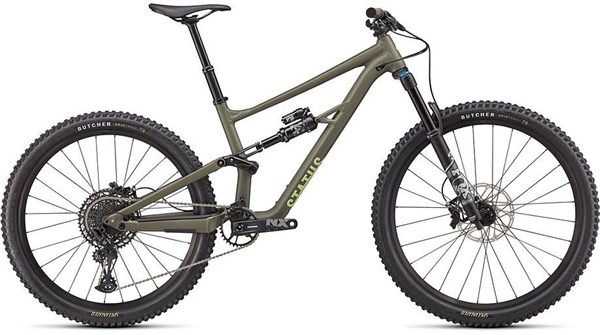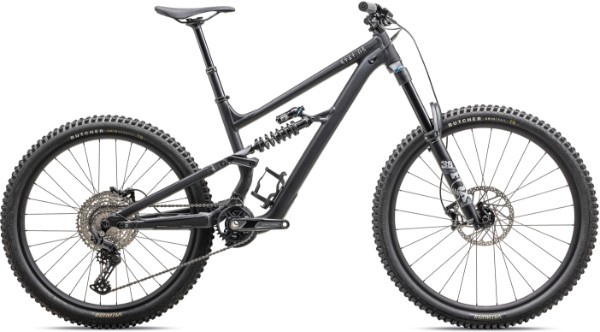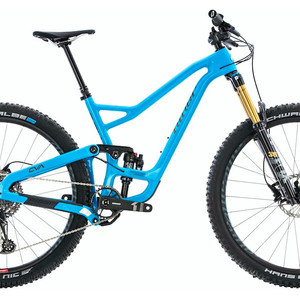2022 Specialized Status 160 Bike
(discontinued)
| Where To Buy | |||
|---|---|---|---|
Free Delivery on purchases over £20.
|
Free Delivery on purchases over £20.
£1,999.00
|
||
Free U.S. shipping on orders over $50, except bikes.
There is a $50 destination fee for bikes. |
Free U.S. shipping on orders over $50, except bikes.
There is a $50 destination fee for bikes. $3,149.99
|
||
STATUS 2 140
$3,149.99
|
|||
STATUS 2 170
$3,149.99
|
|||
STATUS 2 140 ZERO
$0.00
|
|||
STATUS 2 170 ZERO
$0.00
|
|||
STATUS 2 170 DH
$0.00
|
|||
STATUS 2 170 Frameset
$0.00
|
|||
Free shipping on orders over $50 (continental U.S. only).
International shipping available. Some exclusions apply. |
|||
Free shipping on orders over $50 (continental U.S. only).
International shipping available. Some exclusions apply. |
|||

The second generation of the Specialized Status was introduced in 2019 as a purpose-built mixed-wheel trail bike, something Specialized is no stranger to. The latest iteration from Specialized sees some slightly different geometry and a consumer-direct option to have the bike delivered right to your door at a price that won’t break the bank. Focused on fun with an impressive level of versatility, it is a great representation of an affordable do-it-all bike and a great option for people interested in trying mountain biking for the first time as well as someone looking for a purpose-built mullet trail bike.
Strengths
|
Weakness
|
Highlights
- Aluminum frame
- 29/27.5-inch wheels
- 160mm (6.3-inches) of rear-wheel travel // 160mm (6.3-inches) fork travel
- FSR suspension design
- Tapered headtube
- Internal cable routing
- Geometry adjust flip chip
- 160mm or 140mm travel options
- Sold consumer-direct
- Threaded bottom bracket with ISCG05 mounts
- Boost 148mm rear spacing with 12mm through axle
- Measured weight (size S5, no pedals): 33 pounds 12 ounces (15.3 kg)
- MSRP $3,000 USD
Sticking with the tried and true design of the previous generation Status, the changes to this new version appear to be more of refinements rather than radical changes. Specialized kept the sleek, understated graphics with the only branding being an S on the head tube. What largely sets it apart from the previous generation bike is a 140mm travel option. Otherwise, there is now slightly steeper head tube angles from the flip-chip, 1mm longer chainstay, and slightly higher BB heights for high and low settings. Cable routing is tidy and well hidden with only small portions of cable visible to make for nice uninterrupted lines.

Geometry
The Status has gotten slightly less slack and low from the previous generation, likely to help it cater to a wider range of riders and terrain. The low setting will still cater towards higher speed riding with the head tube angle sitting at 63.2-degrees with a 338mm BB height. The high setting becomes a slightly less aggressive 63.7-degree head tube angle with a 347mm BB height. We initially felt the 515mm reach with 800mm wide bars was rather long for a bike with an emphasis on being playful. Cutting the bars to our preferred 780mm helped free up movement a bit.

Setup
We set our test bike up with 28% sag in the rear with the FOX Performance Float X shock at 290psi and the FOX Rhythm 36 set to 115psi with the compression adjustment wide open.



At first, sitting on the bike felt a little stretched out, even at 6’4”. The bike certainly felt better once we actually got it on the trail. We brought the stack height up 5mm to the highest we could get it and would have liked to go slightly higher to feel a bit more upright on the bike. Aside from those fit preferences, the only discomfort in the cockpit came from the profile of the dropper lever which has a rather sharp edge butted up against our thumb knuckle. This could be solved with a file.

On The Trail
The trails we rode felt suitable for the Status with lots of sniper gaps and plenty of large compressions. The majority of our testing was done on the trails of South Mountain in Phoenix, AZ. We also rode some smoother trails out at Hawes in Mesa, AZ as well as some local dirt jump spots.
DH/Technical Performance/Fun Factor
With a focus on fun, pointing the Status downhill is where the bike comes alive. We found it easy to get up to speed and holding that speed felt comfortable. Our initial concerns about the long reach were alleviated after the first lap and feeling the stability of our position on the bike. With the ability to change direction on a dime and pop off of anything in sight, we felt a surge in confidence after our first few turns on the bike and found ourselves pointing the bike at side hits more often than not. Riding the bike casually feels just as rewarding as pushing it to the limit, which should keep just about any gravity-focused rider happy.

Rear Suspension Performance
The rear suspension has a supple feeling that is comfortable for a variety of trail types. We felt the bike was quite calm through the chatter and square edge hits and we were surprised by how well it handled charging rough sections. The rear end does have a less settled feeling than a full 29-inch wheeled bike (as expected) and breaks free somewhat easily but remains predictable. While the FOX Performance Float X shock does not have a low-speed compression adjustment, we felt plenty of low-speed support through transitions and hitting jumps proved to be as fun as we expected it to be.

Unique Features
Simplicity seems to be prioritized over anything extravagant on the Status. You won’t find many exclusive or ultra-unique features here. Perhaps the most interesting part of the Status is its consumer-direct only sales approach. Specialized sells the Status for a flat $3,000 (plus shipping) while the same parts hung off a Stumpummper Evo Alloy will run you $4,000. For that $1,000 savings, riders will forego the SWAT storage and myriad of geometry adjustments that accompany the Stumpjumper Evo. As we said, simplicity is prioritized.
Geometry
With pedal strikes already being a regular occurrence on our rides, we did not experiment with the low setting on trail very much as it felt a bit too low-slung to pedal around Phoenix. We feel it is best suited for high-speed descending on a regular basis. The high setting proved to offer plenty of stability too, setting our third fastest time on one of our test tracks while still feeling competent on traverses and climbs. The stretched out 515mm reach paired with the short 426mm chainstays of our S5 size had us wondering how playful the bike would really feel and we were pleasantly surprised on trail. The geometry put us in a great position for sliding around any turn we could find and allowed us to get creative without needing to leave the ground.

Perceived Weight
Weight perception feels light, especially with an entry-level build kit. Our size S5 weighed in at 33 lbs 12 oz without pedals which seems fairly light given the build kit. On the trail, the bike feels a little sluggish when pointed uphill, but we feel that is more related to the relaxed geometry than it is weight.
Sprinting
We experienced no issues when standing up to sprint. The bike seems to get up to speed just fine and accelerates at a moderate pace. It doesn’t exactly fly out of the gate but it isn’t cumbersome either. Again, we're looking at an alloy 160mm bike with a lot of entry-level parts.

Climbing
The pedaling position feels a bit more relaxed than our personal Stumpjumper Evo. We climbed at a slightly slower pace than usual. We feel the Status 140 may offer slightly more efficient pedaling performance as the short rear end does allow the front wheel to lift easily. This made technical climbing feel slightly difficult through seated compressions with some slight pedal bob and semi-frequent pedal strikes. Out of the saddle, climbing doesn’t require any additional effort.

Build Kit
The build kit of the Status is targeted at price point and simplicity. The price point certainly offers what we feel is a solid bang for your buck. The FOX Rhythm 36 fork paired with the Float X Performance rear shock thoroughly impressed us. The ride quality was terrific in everything from mellow terrain to blitzing the gnarliest rock gardens we could find. The SRAM NX drivetrain shifted flawlessly with the exception of one minor cable adjustment after a bit of break-in time. X-Fusion handles dropper post duties which posed no issues throughout the duration of our test period. The Roval Traverse wheelset uses Specialized/Roval branded hubs and seemed to be a little nicer than the standard 3 pawl hubs we’ve come to expect on an entry-level build kit.

Fork Performance
We felt the FOX Rhythm 36 was a standout feature of the ride quality and served as a reminder to not rule it out as a suspension option when looking for a new bike. We walked away from our test period thinking more people might benefit from its simplicity and easy setup process, leaving less room for error. Performance was phenomenal across all types of riding with our only concern being long-term durability. There was some slight oil seepage from the legs that we are not accustomed to in our testing with FOX forks.


Tire Performance
The Specialized Butcher 2.3 Grid Trail front and rear in the T9 compound offered great traction with a durable tread that should last a good while. Unfortunately, we sliced our rear tire almost immediately on one of our first descents, something that heavier riders will want to consider. We used an equivalent Butcher 2.3 Grid Gravity casing tire we had on hand for the remainder of our test and felt more confident pushing the bike.
Wheel Performance
The rear hub seemed to excrete a good amount, if not all of the grease from the freehub body onto the shell. We experienced a creaking noise under load after a while which seemed to be related to the freehub body/cassette interface. The rims stayed straight the entire time although we did end up with a small flat spot when we sliced the original rear tire and another more serious dent in the rim after a botched line in a high-speed section. Hub engagement does seem slightly higher than other entry-level options.


Brake Performance
SRAM's Code R brakes offered plenty of modulation and stopping power for the majority of our test period. They could definitely benefit from a bleed after a bit of ride time as the lever throw came quite close to the bar after a fair number of steep descents.
Drivetrain Performance
The SRAM NX Eagle drivetrain gave us no issues and surprised us by how smooth it performed, even while shifting under load. The only potential drawback we could see in comparison to a higher level drivetrain could be durability as the cogs started showing signs of wear relatively quickly. Because NX Eagle uses an HG freehub body, riders will need to purchase a new rear wheel if they want to upgrade the cassette, or the reverse being applicable as many nicer wheelsets aren't kitted with an HG body.



Noise
Descending the bike is very quiet with the normal noises expected from rocks and trail debris hitting the downtube of an aluminum frame. We checked all pivot bolts about halfway through our test and found a few needing to be re-torqued, all bolts remained snug for the rest of our test.
What makes the Status rad is the foundation off which it gives consumers to build. We feel the stock build kit functions great for most riders and as things wear out, substantial upgrades become more palatable thanks to the relatively affordable price point of the bike. For us, a Grid Gravity or Downhill casing rear tire would be a necessity. We would swap to a slightly higher rise bar and likely upgrade the wheelset and cassette as well.


Long Term Durability
Despite the number of rocks that bounced off of the down tube in the duration of our test, we saw zero dents and hardly noticeable paint chips. Our rear Grid Trail casing tire and Roval rim were not as lucky, with a tire slice and a slight flat spot on our first ride. We had no issues with the rim bead for the rest of our test but larger or aggressive riders should consider a Grid Gravity casing tire. As awesome as the FOX Rhythm 36 felt on the trail, we did experience some oil seeping from the dust wipers after a couple of weeks which is a concern if not addressed at regular service intervals. Another area we saw dirt accumulate on what appeared to be grease was around the rear hub shell, presumably from the freehub body as a creak while pedaling under load seemed to arise simultaneously.

What's The Bottom Line?
The Status 160 is a lot of fun to ride and performs under a variety of conditions for a variety of riding styles. Specialized provides a great foundation to build off of if you are a newer rider looking for an affordable bike that will open the door to more aggressive riding. If you are a seasoned veteran with a focus on shralping and jibbing your way down the mountain or local jump park, we are certain this bike will speak to you as well. We think if your primary focus is fun, you’ll be pleased with the ride characteristics of the Status. This is the kind of bike we would feel just as comfortable taking to a bike park on a regular basis as we would spinning laps on our local trails.
Visit Specialized.com for more details.

About The Reviewer
Jonathon Simonetti - Age: 28 // Years Riding: 19 // Height: 6'4" (1.93m) // Weight: 225-pounds (102kg)
Jonny started mountain biking in 2003 after taking a trip to Northstar and discovering how much more could be ridden than on a BMX bike. He began racing at age 12 and raced for 12 years until ultimately deciding having fun on a bike was more important. After working in the industry for a few years and developing a deeper understanding of bikes inside and out, he has an aptitude for pairing his riding ability with the analysis of bikes and breaking down what makes them work well. He rides for fun and finds the most enjoyment out of going fast with friends.
1 member reviews
I love the bike would recommend to anyone. So much fun
1 comments
Post a reply to: Love this bike
Specifications
Drop: 125mm (S1), 150mm (S2/S3), 170mm (S4/S5)
• Mixed ("Mullet") wheels: 29" front, 27.5" rear
• Internal cable routing
• Sealed cartridge pivot bearings
• Geometry adjustable via flip chip in shock yoke
| Where To Buy | |||
|---|---|---|---|
Free Delivery on purchases over £20.
|
Free Delivery on purchases over £20.
£1,999.00
|
||
Free U.S. shipping on orders over $50, except bikes.
There is a $50 destination fee for bikes. |
Free U.S. shipping on orders over $50, except bikes.
There is a $50 destination fee for bikes. $3,149.99
|
||
STATUS 2 140
$3,149.99
|
|||
STATUS 2 170
$3,149.99
|
|||
STATUS 2 140 ZERO
$0.00
|
|||
STATUS 2 170 ZERO
$0.00
|
|||
STATUS 2 170 DH
$0.00
|
|||
STATUS 2 170 Frameset
$0.00
|
|||
Free shipping on orders over $50 (continental U.S. only).
International shipping available. Some exclusions apply. |
|||
Free shipping on orders over $50 (continental U.S. only).
International shipping available. Some exclusions apply. |
|||











































26 comments
Post a reply to: Vital Review - Specialized Status 160